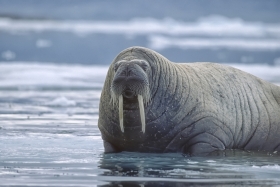Alarming data on Arctic Ice Loss

The Antarctic ice sheet has lost ice twice as quickly in the past
three years as when it was last surveyed between 2005 and 2010, say
scientists.
Results from the CryoSat-2 satellite mission, published today in the
journal Geophysical Research Letters, say the largest ice sheet on Earth
is now losing 159 billion tonnes of ice each year.
The overwhelming majority is coming from West Antarctica and the Antarctic Peninsula, with the East of the continent responsible for just two per cent of the decline.
Altogether, Antarctic ice loss is now contributing 0.45 millimetres to global sea level rise each year. Between 1993 and 2010, total sea level rise was 3.2 mm per year.
'Although we are fortunate to now have, in CryoSat-2, a routine capability to monitor the polar ice sheets, the increased thinning we have detected in West Antarctica is a worrying development,' says Professor Andrew Shepherd, of the University of Leeds, who led the study.
'It adds concrete evidence that dramatic changes are underway in this part of our planet'
Prof Andrew Shepherd,
University of Leeds
'It adds concrete evidence that dramatic changes are underway in this part of our planet, which has enough ice to raise global sea levels by more than a metre.'
The news comes just days after scientists announced at a NASA press conference that the ice along the Amundsen Sea sector of West Antarctica has now entered an irreversible decline.
The region is almost as large as France, and is home to some of the largest glaciers on Earth, including the Pine Island glacier, and Thwaites glacier.
Over the coming centuries, the loss of that section of ice alone will cause a global sea-level rise of a metre. But it is also likely to trigger the collapse of the rest of the West Antarctic ice sheet, which would trigger a global rise in sea levels of up to five metres.
In contrast, the east of the continent remains relatively stable. A recent study suggested that rising greenhouse gases in the atmosphere are causing the ocean wind between Australia and Antarctica to strengthen, locking in cold air over the east of the ice sheet, while pushing warm air over the west.

ESA's Cryosat-2.
CryoSat-2 was launched in 2009 by the European Space Agency. Using a specially designed radar altimeter, which fires pulses of microwave energy down towards the ice sheet, it is able to monitor small changes in the height and shape of the ice in fine detail.
Until now, precise predictions of future sea-level rise have been held back by our incomplete understanding of current changes in the world's major ice sheets. But the improved technology on CryoSat-2 has allowed scientists to produce a comprehensive estimate of ice losses in some of the most rugged areas of Antarctica for the first time.
'The increasing contribution of Antarctica to sea-level rise is a global issue, and we need to use every technique available to understand where and how much ice is being lost,' says Professor David Vaughan, of NERC's British Antarctic Survey, who was not involved with the study.
'Prediction of the rate of future global sea-level rise must be begin with a thorough understanding of current changes in the ice sheets - this study puts us exactly where we need to be.'
'Whether we should do something about it is simply a matter of common sense. And the time to act is now; Antarctica is not waiting for us'
Prof Eric Rignot
Exactly how much of the rapid ice loss from West Antarctica is down to human activity remains uncertain. Writing in The Observer, Professor Eric Rignot, a glaciologist at NASA's Jet Propulsion Laboratory, says, 'This part of the continent was likely to retreat anyway, but we probably pushed it there faster.'
'Unabated climate warming of several degrees over the next century is likely to speed up the collapse of West Antarctica, but it could also trigger irreversible retreat of marine-based sectors of East Antarctica,' he adds.
'Whether we should do something about it is simply a matter of common sense. And the time to act is now; Antarctica is not waiting for us.'
Malcolm McMillan, Andrew Shepherd, Aud Sundal, Kate Briggs, Alan Muir, Andrew Ridout, Anna Hogg, Duncan Wingham, 'Increased ice losses from Antarctica detected by CryoSat-2', Geophysical Research Letters, 2014.
Read more at Planet Earth Online.
http://www.enn.com/ecosystems/article/47406